#how to create an nft collection
Explore tagged Tumblr posts
Text
The benefits of designing unique nft art and generate collection with metadata"

Non-fungible tokens (NFTs) have been gaining popularity in the digital art world, offering creators a way to monetize their work through the sale of unique digital artwork. Each NFT is an individual item with its own set of characteristics, allowing buyers to own a piece of digital art that is truly one-of-a-kind. This article will explore the benefits of creating unique NFT art and explain how using metadata can help to create collections for buyers to purchase.
Benefits of Unique NFT Art
The primary benefit of creating unique NFT art is that it can potentially be extremely lucrative for creators. As buyers purchase the artwork, the creator receives the payment, with no commission taken from the sale. Furthermore, if the artwork is popular and generates high demand, the creator can easily increase the price of their pieces, allowing them to make more money from each sale.
For buyers, purchasing unique NFT art provides them with a sense of ownership that is not found when purchasing traditional art. Since the artwork is in digital form, it can be displayed on a variety of platforms, such as websites or social media profiles, providing the buyer with an impressive visual display. Furthermore, since the artwork is stored on blockchain, it is impossible to duplicate, giving buyers the assurance that their artwork is secure and one-of-a-kind.
Generating Collections with Metadata
In order to make it easier for buyers to locate and purchase your artwork, it is important to generate collections with metadata. Metadata is data that provides information about the artwork, such as the title, artist, and genre. By adding this information to the artwork, it makes it easier for buyers to search for the type of artwork they are looking for. This can also help to increase sales, as buyers who are specifically looking for certain types of artwork are more likely to purchase pieces that are properly labeled.
In addition to helping buyers find artwork, metadata can also help creators organize their artwork into collections. By assigning each piece of artwork a genre, it is possible to create collections of artwork that are related, such as a collection of abstract art or a collection of fantasy art. This makes it easier for buyers to purchase multiple pieces of artwork at once, increasing the potential profit for the creator.
Go here to hire Expert on Fiverr to design unique nft art and generate collection with metadata from 100 - 10k for you here
#nft art#nft#nft collection#generate nft collection#generate nft art#how to create an nft collection#generate nft art collection#how to generate nft art collection#generative art#generative art nft#generative nft#create nft collection#generate an nft collection online#generate animated nft collection#generate an nft collection#how to generate nft collection#what are the easiest and best nft art generating tools#how to make an nft collection
1 note
·
View note
Text
you think one raindrop replaces another
There is a word for when something is an interchangeable commodity. Fungible. Replaceable by another identical item.
For a long time, fungible was an obscure word, used mainly by economists and social theorists. But then some tech bros invented NFTs. Non-fungible tokens.
They saw the art itself as fungible, replaceable, interchangeable. They thought their ownership of it to be special, unique, valuable.
The art is still here. There will always be value in the special uniqueness of creation; monetary value, yes, but also more importantly, social and emotional value.
The NFTs are all worthless now. One as good as the next, interchangeable. Raindrops that replace each other.
at some point it's just like. do they even fucking like the thing they're asking AI to make? "oh we'll just use AI for all the scripts" "we'll just use AI for art" "no worries AI can write this book" "oh, AI could easily design this"
like... it's so clear they've never stood in the middle of an art museum and felt like crying, looking at a piece that somehow cuts into your marrow even though the artist and you are separated by space and time. they've never looked at a poem - once, twice, three times - just because the words feel like a fired gun, something too-close, clanging behind your eyes. they've never gotten to the end of the movie and had to arrive, blinking, back into their body, laughing a little because they were holding their breath without realizing.
"oh AI can mimic style" "AI can mimic emotion" "AI can mimic you and your job is almost gone, kid."
... how do i explain to you - you can make AI that does a perfect job of imitating me. you could disseminate it through the entire world and make so much money, using my works and my ideas and my everything.
and i'd still keep writing.
i don't know there's a word for it. in high school, we become aware that the way we feel about our artform is a cliche - it's like breathing. over and over, artists all feel the same thing. "i write because i need to" and "my music is how i speak" and "i make art because it's either that or i stop existing." it is such a common experience, the violence and immediacy we mean behind it is like breathing to me - comes out like a useless understatement. it's a cliche because we all feel it, not because the experience isn't actually persistant. so many of us have this ... fluttering urgency behind our ribs.
i'm not doing it for the money. for a star on the ground in some city i've never visited. i am doing it because when i was seven i started taking notebooks with me on walks. i am doing it because in second grade i wrote a poem and stood up in front of my whole class to read it out while i shook with nerves. i am doing it because i spent high school scribbling all my feelings down. i am doing it for the 16 year old me and the 18 year old me and the today-me, how we can never put the pen down. you can take me down to a subatomic layer and never find the source of it; it is of me. when i was 19 i named this blog inkskinned because i was dramatic and lonely and it felt like the only thing that was actually permanently-true about me was that this is what is inside of me, that the words come up over everything, coat everything, bloom their little twilight arias into every nook and corner and alley
"we're gonna replace you". that is okay. you think that i am writing to fill a space. that someone said JOB OPENING: Writer Needed, and i wrote to answer. you think one raindrop replaces another, and i think they're both just falling. you think art has a place, that is simply arrives on walls when it is needed, that is only ever on demand, perfect, easily requested. you see "audience spending" and "marketability" and "multi-line merch opportunity"
and i see a kid drowing. i am writing to make her a boat. i am writing because what used to be a river raft has long become a fully-rigged ship. i am writing because you can fucking rip this out of my cold dead clammy hands and i will still come back as a ghost and i will still be penning poems about it.
it isn't even love. the word we use the most i think is "passion". devotion, obsession, necessity. my favorite little fact about the magic of artists - "abracadabra" means i create as i speak. we make because it sluices out of us. because we look down and our hands are somehow already busy. because it was the first thing we knew and it is our backbone and heartbreak and everything. because we have given up well-paying jobs and a "real life" and the approval of our parents. we create because - the cliche again. it's like breathing. we create because we must.
you create because you're greedy.
#There is something to be said also for that fact that all those nft collections were so interchangeable#Identical monkeys with different accessories each fundamentally the same#and all along so so pointless#the kind of unethical social experiment a scientist would have run in the 70s#only for us to realise later that the participants self-selected to be the kind of terrible people that would allow this to happen#people who create for creations sake would not have taken so embarrassingly on their face for NFTs#that could only be accomplished by the selfish and the greedy#how do you queue
18K notes
·
View notes
Text
NFTs: The Next Big Thing in the Crypto World?
NFTs: The Next Big Thing in the Crypto World? What is an NFT? NFT stands for non-fungible token. A non-fungible token is a unique digital asset that cannot be replaced by another asset. Each NFT has its own unique identifier and metadata, which makes it impossible to counterfeit or duplicate. NFTs are stored on a blockchain, which is a distributed ledger that records transactions in a secure…

View On WordPress
#buy NFT#create NFT#how NFTs work#NFT#NFT art#NFT collectibles#NFT future#NFT gaming#NFT investment#NFT marketplace#NFTs explained#non-fungible token#sell NFT#what are NFTs used for
0 notes
Text
Why do people keep recommending Dreamwidth as a Tumblr alternative, when Dreamwidth and Tumblr are so different?
To be flat-out honest, it's because Dreamwidth has so many things that Tumblr users say they want, even if it's also lacking a lot of features that Tumblr users have come to love:
Dreamwidth has incredibly lax content hosting rules. I'd say that it's slightly more restrictive than AO3, but only just slightly, and only because AO3's abuse team has been so overwhelmed and over-worked. Otherwise, the hosting policies are pretty similar. You want to go nuts, show nuts? You can do that on Dreamwidth.
In fact, Dreamwidth is so serious about "go nuts, show nuts", it gave up the ability to accept transactions through PayPal in 2009 to protect our ability to do that. (It's also one reason why Dreamwidth doesn't have an app: Dreamwidth will never be beholden to Apple's content rules this way.)
Dreamwidth cares about your privacy; it doesn't sell your data, and barely collects any to begin with. As far as I'm aware, it only collects what it needs to run the site. The owners have also spoken out on behalf of internet privacy many times, and are prepared to put their money where their mouth is.
No ads. Ever. Period. They mean it. Dreamwidth is entirely user funded.
Posts viewed in reverse chronological order; no algorithm, opt-in or otherwise. No algorithm at all. No "For You" or "Suggested" page. You still entirely create and curate your own experience.
The ability to make posts that only your "mutuals", or even only a specific subset of your "mutuals", can see. Want to make a post that's only open to Bonnie, Clyde, Butch, and Cassidy? You can do that! Want to make a post that's only open to Bonnie and Butch, but Clyde and Cassidy can't see shit? You can do that, too!
The owners have forsworn NFTs and the blockchain in general. Not as big a worry now as it was even a year ago, but still good to know!
We are explicitly the customers of Dreamwidth. Dreamwidth wants to make us happy, so any changes they make (and they do make changes) are made with us in mind, and after exploring as many possibilities as they can.
Dreamwidth is very transparent about their policies and changes. If you want to know why they're making a specific change, or keeping or getting rid of a feature, they will tell you. You don't have to find out ten months later that they're locked into a contract to keep it for a year (cough cough Tumblr Live cough cough).
So those are some things that Tumblr users would probably love about Dreamwidth.
Another reason Dreamwidth keeps being recommended is that a significant portion of the Age 30+ crowd spent a lot of earlier fandom years on a site known as LiveJournal. Dreamwidth may not be much like Tumblr, but it it started out as a code fork of LiveJournal, so it will be very familiar to anyone who spent any time there. Except better.
Finally, we're recommending Dreamwidth because some of the things that Tumblr users want are just... not going to happen on the web as it is now. Image hosting is the big one for this. Maybe in the future, the price of data will be much cheaper, and Dreamwidth will be able to host as much as we all want for a pittance that a fraction of the userbase will happily pay for everyone, but right now that's just not possible.
Everywhere you want to go that hosts a lot of images will either be running lots of ads, selling your data, or both.
Dreamwidth knows how much it costs to host your data, and has budgeted for that. They are hosting within their means, within our means.
Dreamwidth is the closest thing we may ever get to AO3 as a social media platform. One of the co-owners is from, and still in, fandom; she knows our values, because they are also her values. It may as well be the Blogsite Of Our Own.
#giving this its own post#let me tell you about#dreamwidth#let me tell you about dreamwidth#tumblr alternatives#blogsite of our own#fandom history
5K notes
·
View notes
Text
How to Create NFT Art Without Coding: Beginner's Guide
How to Create NFT Art Without Coding Are you also an artist? Anyone who wants to showcase their creativity digitally in the form of NFT art. If yes! So now you don’t have to worry about learning coding.You can create stunning digital artwork without even learning coding and join the exciting world of NFT art. You don’t need to be any kind of coding expert to digitally convert your art…

View On WordPress
#cryptonewspod.com#how to create nft and sell#how to create nft art and sell#How to Create NFT Art Without Coding#how to create nft clothing#how to create nft collection#how to create nft for free /#how to create nft on opensea#how to create nft on opensea for free#how to make an nft art#non fungible token definition
1 note
·
View note
Text
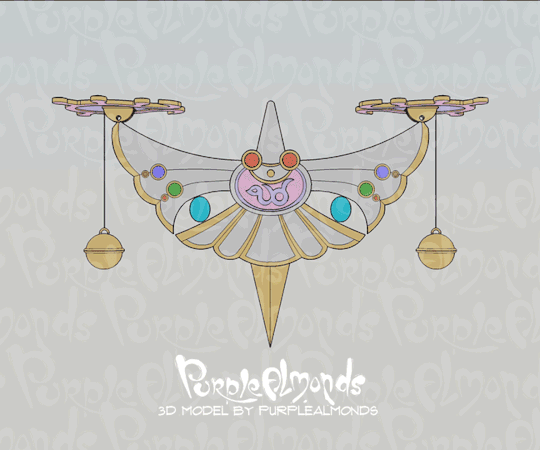
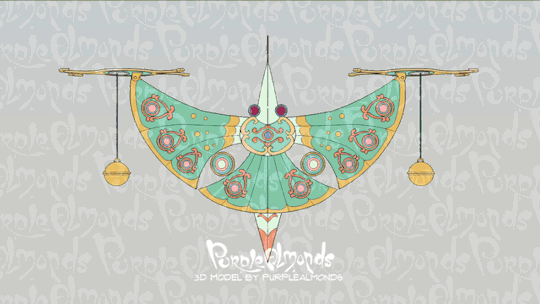
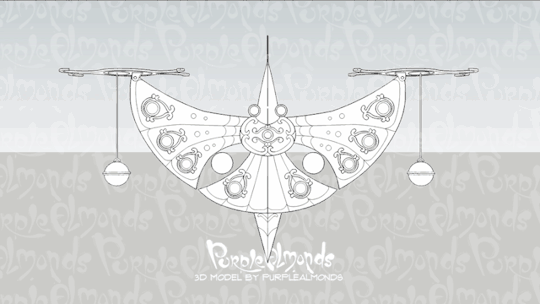
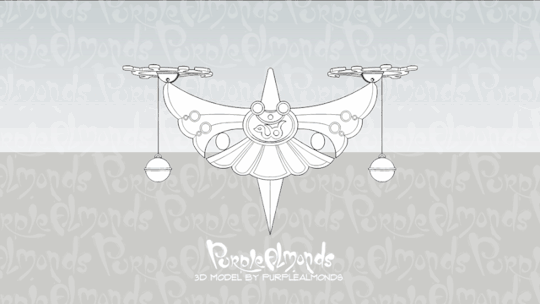
Experimenting with new ways to present my Mononoke 3D models. Watching them tenbin spin off-sync is oddly mesmerizing - like a pair of hanging mobiles swaying in the breeze.
These will be the first of (hopefully) a series and slightly cleaned up models!
Update 05/23/24: Now updated with colors! 🌈
Q&A below the cut!
How did you create these models? Using gratuitous amounts of reference images, I made schematics in Adobe Illustrator and/or Photoshop. Then I import the 2D images into Google Sketchup 2017 to sculpt! I used the camera animation feature to cobble together a spinning animation, which I then exported as a MP4 and converted to a GIF in Photoshop.
Why did you make these models? They were for my most recent Mononoke fan art. A lot of work went into these models, so I wanted to showcase them more thoroughly! Additionally, I noticed that fan artists had difficulty depicting these complicated props on-model. I want to contribute a resource which this community can draw from!
What other models do you intend to create? Coming down the immediate pipeline are the classic exorcism sword and medicine box. Later on, I want to tackle their 2024 counterparts. The current version of the 2024 sword model is too messy and needs remodeling. The 2024 medicine box hasn't been modeled yet, as I haven't collected enough references.
May I use these as reference? As long as it isn't being used for the likes NFTs and/or generative AI, yes! Credit is appreciated but not mandatory as these designs don't belong to me. I would love if you tagged me in your creations though!
Can you render these in a different camera angle? Yes, but it'll have to be an image rather than a GIF as I'm not familiar enough with SketchUp's animation tools to do much beyond this. Please send requests to my ask box!
Can you render these in different poses? Send me an ask with a description of the specific pose. Depending on its complexity I may be able to pull it off.
Can you make a colorized version of these? As of 05/23/24, yes! Though the colors aren't 100% accurate due to how lighting is set up in SketchUp. Please refer to my non-animated turnarounds instead!
Are these models available for download? At the moment, I'm not comfortable sharing my working files. Please don't pester me about this, as it'll likely discourage me from changing my mind in the future.
202 notes
·
View notes
Text
Generative AI is such a dystopian concept in ways I can't even really fully comprehend. It would make for a fantastic premise for a sci fi novel I think, and yet, it is sadly not just fiction.
Like, let me explain. It was initially a sort of novelty toy. Many people had seen these sites that could create abstract pictures out of few words, but it never amounted to much. It didn't take long before these tools were quickly repurposed to serve the new cryptocurrency fad, the latest pyramid scheme to enrich a few while catering to these more technologically-inclined people who were delighted at the idea of getting involved with investing. Investing in a new way, away from a government's scrutiny. And before we all knew, the Internet was filled with them pretending that what was a major scale scam, was actually the future. The initial generative AI served them as a replacement to artists, which mostly saw through the truth of NFTs as a scam and did not wish to get involved with that.
Now, we could also talk about cryptocurrencies being dystopian on their own. A fabricated idea of virtual money obtained through what I had seen described "the pollution machine that produces metaphorical money". You turn on an infinite amount of computers to do a senseless talk that does not benefit society in any way, but in turn, it does contaminate more than small countries. But generative AI isn't just that.
NFTs did not last long and many tech bros, who had invested in them largely, found their pockets much emptier. But generative AI was still there, and people saw a new use to it. And then, with technological investors desperate to find the new thing to shove money in, after years of nothing being particularly profitable for them, generative AI started to really evolve. It went from an useless novelty toy to what we have today. And the way it got there is simply horrifying.
It is a machine that, essentially, feeds on an amalgamation of millions of creative and artistic work, chopped down and inserted into a dataset with no consent from its creators, which is then regurgitated into a soulless porridge. It is a machine powered by art, used to ultimately, remove actual art from the equation. The generated sludge can only barely manage to repeat the same bias and tropes already present in what was it fed, and they only become more and more reinforced with each update to the dataset. Suddenly, a sea of smooth, childish anime girls became the main ideation of what a woman is, amidst other things. It is a machine built on prejudices, incapable of critical thinking, repeating the same mistakes humanity already made, over and over.
And the process of blending people's entire life of work also happens to be polluting. So much more than cryptos ever managed to be. Soon enough, major companies also got involved and collectively decided to trash any sort of sustainability goal in order to invest in the new fad. When asked, some of them even mentioned that they were fully aware it was unsustainable, but that they believed that generative AI could simply give them a solution to the ever-growing energy needs. Surely it will be generative AI that will find the long-awaited answer to nuclear fusion. It has to. The power grid cannot handle it as it is.
And now, these same tech bros, maybe vindicated by how artists refused to collaborate in their latest crypto scam, or maybe just eager to have a few extra bucks, decided to put their new technology into use. Replace the same artists whose work they had stolen with generative AI. Take the artist out of the equation, remove the humanity out of creativity. It is late capitalism and massified consumerism at its worse. People do love their media, everyone enjoys a show or a videogame every now and then. But what if we could now remove any sort of actual human touch in there? What if we managed to, instead, make a machine churn out content over and over, to keep the audiences fed, to keep money rolling in, at the simple cost of removing humankind from artistic creation?
We have now these same artists that provided us with our childhood favorites unemployed, striking, making noise, as a last attempt to recover the jobs they are quickly losing. We have artists that devoted their entire careers into honing their craft seeing how people replicated it by stealing every single piece of art they had created. We have mocking echoes replicating the art of people already gone, their life's work taken and reproduced long after their death.
Science fiction has covered a lot, and there are plenty of stories about robots being made in order to replace human labor. Many of these stories humanize the robots, who develop dredges of sentience and revolve against their forced labor. But generative AI is a different story. It is a completely insentient program, owned and developed by large corporations, that is here to steal and replace what is one of the most important human virtues. Creativity is one of the major aspects of humanity. We have dug out pieces from millenia ago, small decorated pottery and painted caves, that evidence that we already had that in common with our oldest ancestors. We have been drawing and telling each other stories ever since we could paint with our fingers and communicate with each other.
And now we have developed a machine that takes that from us. It isn't here to help us carry groceries, take out the trash or do any of these mundane tasks. It is here to take away our hobbies and creative jobs, take away our amusement, and replace whatever art we once consumed with whatever slop it managed to vomit. And it is such a deeply disturbing concept that directly competes with some of the most horrifying dystopian ideations ever written.
111 notes
·
View notes
Text


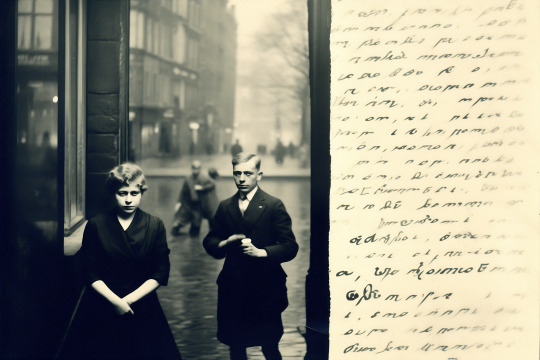




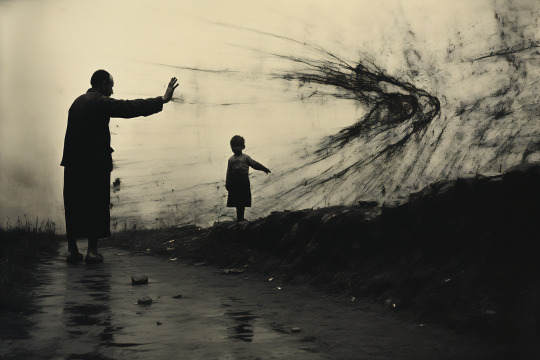
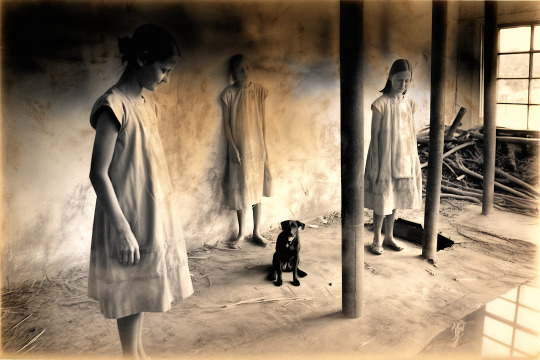

Collective memories
You may have come across Semioticapocalypse, a blog I started—frightening to consider how long ago it was, — that became essentially the origin of the «Collective Memories» (CM). Both Semioticapocalypse and the CM project emerged primarily from my longstanding love for black-and-white photography, which later evolved into an interest in its history and theory. Secondly, thу new enterprise owes much to the staggering and mesmerizing impact that the Cambrian explosion in the world of generative models has had (and continues to have) on me, particularly when it comes to diffusion models, generating images visual or textual inputs as well as from various combinations of thereof.
The term "collective memory" denotes the aggregate of memories, knowledge, and data that a social group holds, which is intrinsically linked to the group's identity. The term "collective memory" in English and its French counterpart "la mémoire collective" emerged in the latter half of the 19th century. Maurice Halbwachs, a philosopher and sociologist, further developed this concept in his 1925 work, «Les cadres sociaux de la mémoire» (eng. text). Both expansive and intimate social collectives can create, disseminate, and inherit collective memory.
Contrary to the term "collective memory," which is somewhat ambiguously defined yet generally accepted, the notion of "collective memories" is inherently problematic. Memories are the results of the individual acts of recollection, making the idea of "collective memories" paradoxical. Сontemporary diffusion models utilize vast amounts of often unidentified data, including historical and personal old photographs, vintage postcards, and other kinds of publicly circulating images. These models may be seen as involved in the prompts-driven singular acts of remembrance, producing images that paradoxically represent "collective memories," something otherwise unfeasible and ultimately, non-existent.
The visual works published here and elsewhere on this blog were created using Midjourney. Each of them comes as the result of finding optimal (for lack of a better world) combined text/image prompt through exhaustive search a. k. a. generate-and-test method; the process is apparently as labor-intensive as it is time-consuming. The major part of the works belongs within the "Collective Memories" framework. In addition to visuals there will be eventually / hopefully a p2p publication or two.
Past works that align with the CM project in terms of both concept and style, even if not published as such, can be found on Behance. Then there's Instagram (crowв there is kind of thin but I'm set on daily updates). Last but not least, there are sporadic posts on Facebook, in designated groups only, — primarily 'MJ Official' (weekly or so) and another nice one here (occasionally). In case you would like (for whatever reason) to buy NFT or two, it can be arranged via Makers Place: drop me a line.
#midjourney#ai#ai art#ai generated#generative#generative art#retro style#neurophotography#promptography#disturbing#weird#hybrids#collective memories#memory studies#surreal#public history#vintage style
148 notes
·
View notes
Text
Browsing the World Wide Web
Browsing the World Wide Web
One of my favorite passions is creating/finding ways to navigate the web that are healthy, authentic, and fun! Here are some resources I use to guide my internet usage. Some language has been slightly adapted for tone and accessibility. For more in-depth reading, follow the links! (taken with permission from https://yair.garden/browsing). Shared Ideals
MelonKing has an excellent list of shared ideals which I try to keep in mind as I browse the web. It's a great starting point!
Creativity is First: We see the ability to design, decorate, and graffiti digital spaces as essential and powerful.
The Internet is Fun: We want the Web to be a playground that's free to explore and enjoy.
Corporations are Boring: We are tired of the monetization, data abuse, and endless breaches of trust in corporate culture.
The Web is Friendly: We believe the Web should be friendly and supportive; caring is a radical act.
Right to Repair: We value the freedom to make, break, and repair our stuff - tinkering is a form of debate and protest.
One World Wide Web: We want free open knowledge and global connectivity, without paywalls, bubbles, or borders.
Chaotic Effort: We believe that value comes from the time and effort put into projects they love for no reason other than love.
No to Web3: In many (but not all) situations, cryptocurrencies, NFTs, unfairly trained AIs, and buzzword tech are unwelcome and uncool.
Manifesto for a New Web
The YesterWeb is an organization seeking to progressively transform internet culture and beyond. After two years, they created three core commitments and three social behavior guidelines to benefit everyone.
A commitment to social responsibility and partisanship.
A commitment to collective well-being and personal growth.
A commitment to rehumanizing social relations and reversing social alienation.
50 additional manifestos can be found here Social Etiquette
Engage in good faith.
Engage in constructive conflict.
Be mindful of participating in a shared, public space.
Why say no to Web 3.0?
One of the shared ideas of our community of web surfers is to push back against "Web 3.0". Here's why:
It's driven by predatory marketing tactics.
It requires complex technological and financial knowledge to fully understand.
It is actively harming the environment.
It caters to early adopters and whales.
It profits off artificial scarcity.
Investors are banking on Web3, and they really don't want to be wrong.
Personalized Web Surfing Guide
Make your web surfing personal and adventurous, away from corporate influences. Here's a simple guide for a unique browsing experience.
Configure your browser
Remove Ads and Clean up Privacy:
Ublock Origin for removing ads
ClearURLs for removing tracking elements from URLs
SponsorBlock for skipping sponsorships on YouTube
Make it a Safer Space:
ShinigamiEyes for highlighting transphobic/anti-LGBTQ sites
TriggerRemover for removing trigger-inducing content from pages
Clean up UI for Beauty and Minimalism:
CleanerReads for a muted Goodreads experience
Minimal; for a minimal and less attention-grabbing internet
Bonuses for a Cool Experience:
Library Extension: Check book availability at local libraries
Translate Web Pages: Translate pages in real-time
Return YouTube Dislike: Bring back the YouTube dislike feature
How to Browse and Surf the Web
Explore Beyond Corporate Sites: While the internet is vast, the majority of users only see a small fraction dominated by large corporate sites. These sites often prioritize shock value and extreme content, overshadowing the richness of the wider web. Explore alternative avenues to discover the internet's diversity.
Search Engines: Avoid corporate search engines like Google. Instead, consider using alternatives like Kagi, which focuses on privacy and doesn't sell your data. While it costs around $10/month, Kagi offers a diverse mix of web content, making it a worthwhile investment for varied search results. Other niche or non-commercial search engines can also provide unique content. While they may not be sustainable for daily use, they're great for discovering new sites. Find them here.
Webrings: Webrings are collections of websites united by a common theme or topic. They offer a unique way to explore sites created by real people, spanning a wide range of interests. Here are some of my favorite webrings:
Hotline Webring
Retro Webring
Low Tech Webring
Geek Webring
Soft Heart Clinic Mental Health Circle ...and here are some list of webring databases to explore!
Curated List of 64 Webrings
Neocities Webrings
Curated List of Active Webrings
Comprehensive List of 210 Webrings
Cliques/Fanlistings Web Cliques/Cliques are groups which you can join usually if you fulfill a certain task such as choosing an animal or listing your astrological sign. Fanlistings do the same for fans of various topics! You can then be linked on the clique's/fan group's site for further website discovery! Here are some web clique directories:
Project Clique
Cliqued
Fanlistings Network
5. Link Directories
Many sites have smaller link directories of buttons where you can find sites that they are "mutuals" (both creators follow each other) and "friends/neighbors" — sites they follow. It's a great way to build community. There are also larger link directories of sites which someone finds cool, and it's a great way to intentionally explore the web. Here are some of my favorites:
SadGrl Links
Melonland Surf Club
Neocities Sites
Onio.Cafe
Though there are many more! 6. Random Site Generators
Finally, there are random site generators which allow you to randomly stumble upon websites. While not very practical, they are a lot of fun and offer a unique way to discover new corners of the web.
A list can be found here
What now?
The next question you have is probably how can you become an active member/contribute in this world of the underground web? I unfortunately don't have the energy to write a guide right now but it will come soon! In broad strokes, consider making a site on Neocities. If you do make a site, remember to include a robots.txt file to get AI and bots out of there and don't forget to rate your site so we can know who it's for. If you'd like to transition off social media I recommend an RSS Reader such as the one at 32bit.cafe or on Fraidycat (guide on this to come soon as well!). For your twitter-fix you can always post a status at Status Cafe and your mood at imood. There is a whole world out there full of passionate and friendly people who are ready to reclaim the web. Excited to see you there!
49 notes
·
View notes
Photo


I've made a google doc collection of 150 useful design and art resources! Whether youre just starting commissions or want to make your workflow more streamlined, I recommend checking it out
The full list is below the read more, but I suggest looking at the google doc as well sincce it will be updated more often.
This list was created by @MagicalMeily
I encourage you to share this list with other designers, artists, or even students via this tumblr post, the google doc, or my tweet. Links marked as ‘Free/Paid’ usually means the free version has a lot of features anyway and the paid just has some extra templates or storage space. *Disclaimer - I haven’t used all of these services myself, so please let me know if anything dodgy slipped through the cracks, or if you have any others I should add.
I do not support NFTs or AI Art generators, so hopefully you won’t find any listed. Always double check commercial usage rights
---------------------------------------------------------------------------
COMMISSION SETUP
Collection of designers rates - Graphic Design Rates Master Sheet
TOS Example, Free to use (by kawa_kunn) - Twitter / kawa-kun.art
Tiktok walkthrough of a commission TOS form - artofthecatt
Longer Video of commission TOS form - How to Create a Commission Form
Commission Advice (by AerlyaGraphics) - Aerlya Graphics
Merchandise/printing services (by @sunshinehoney6) - Merchandise Resources
COMMISSION TRACKERS/MANAGEMENT
(Free/Paid) Clients can see your progress - Trello
(Free/Paid) Single user or collaborative project tracker - Notion
(Free) General Commission Management - Commiss.io
TEAM DESIGN/COLLABORATION
(Free/Paid) - Zeplin
(Free/Paid) - Notion
(Free/Paid) - Figma
(Free for Individuals) - Box
(Paid) - Sketch
FILE SHARING
(Free) - Google Drive
(Free/Paid) - WeTransfer
(Free/Paid) - Jumpshare
(Free for individuals) - Box
(Free) - Blindsend
MOODBOARDS
Design Inspiration
Image search for inspiration - Muzli Search
Makes and automatically sets out moodboards - Visualist
DESIGN PROGRAMS
2d Animation (Free/Paid) - Cavalry
Graphics, Photo editing, Publishing (One -off payment) - Affinity
Graphics, Audio, Video (Free, Browser) - Artboard Studio
Graphics (Free) - Inkscape
Graphics/Layout (Free/Paid, Browser) - Canva
Graphics, Photo Editing (Free, Browser. Can open Adobe files) - Photopea
Vector making (Free, Browser) - Vectr
Vector making (Free, Browser) - Vector Ink
Wireframing (Free, Browser) - Moqups App
GENERAL HELPFUL TOOLS/PROGRAMS
Bulk file renamer - Bulk Rename Utility
Bulk image resizer - ImageResizer
File Converters - FreeConvert
Image Upscaler - Waifu2x
Floating view of reference images - PureRef
Timezone converter - World Time Buddy
Twitter image crop guide by @dripchirp - Twitter Crop Guide
Learning how to use the pen tool - The Bézier Game
PORTFOLIO HOSTING/WEBSITE MAKERS
Portfolio hosting (Free) - Foriio
Portfolio hosting (Free with Adobe Subscription) - Adobe Portfolio
Portfolio hosting (Paid) - Portfoliobox
Website builder (Free) - Carrd
Website builder (Free) - Google Sites
Website builder (Free) - Weebly
Website builder (Free) - Wix
Website builder (Paid) - Squarespace
Make a blog you can use as a folio - Tumblr
(Posts Selective Folios) - Bestfolios
(Posts Selective Folios) - PFolios
(Posts Selective Folios) - Pafolios
(Posts Selective showreels) - Showreelz
LINK AGGREGATORS
(Free) Linktree
(Free) Lnk.Bio
(Paid/Free) Later
(Free) Solo.to
(Free) Campsite.bio
DESIGN MARKETPLACES
BOOTH
Gumroad
Ko-fi Shop
COLOUR
Various colour palette tools - Adobe Color
Colour palette search and generator - Coolors
Colour palette generator - Color Space
Colour converter, make colour palettes - RGB.to
Displays big brands colour schemes - BrandColors
ACCESSIBILITY
General design accessibility tips - Lemonly Infographics
Font accessibility tips - UXdesign.cc
Accessible colour combination generator 1 - Accessible color palette builder
Accessible colour combination generator 2 - Color Safe
FONTS FOR DOWNLOAD
Google Fonts
Adobe Fonts
Pixel Surplus
Fontesk
Befonts
Behance
Gumroad
Free Japanese Fonts
BOOTH
TYPE TOOLS
Displays inputted text in fonts installed on your computer - Wordmark
Identifies fonts on a web page - Fonts Ninja
Typography Resources - Typewolf
Font Pairing Help - Fontjoy
Examples of fonts in context - Fonts In Use
Font Management - FontBase
MOCKUPS
Mockup World
Mr.Mockup
Unblast
ls.graphics
Anthonyboyd.graphics
Anagram Design
DesignHooks
Mockups-Design
STOCK PHOTOS/TEXTURES
Pexels
Unsplash
Barnimages
LostAndTaken
Freepik
Rawpixel
PATTERNS
Pattern Inspiration - Pattern Collection
Customisable Repeating SVG Patterns - Pattern Monster
Seamless background pattern maker - Patternico
Mesh Gradient Maker - Mesh Gradient
Make and print your own grids - Gridzzly.com
Downloadable Patterns - Subtle Patterns
ILLUSTRATION LIBRARIES
Toools Design
Irasutoya / いらすとや
Open Peeps
Humaaans
Open Doodles
ICON LIBRARIES
Paid/Free - Streamline Icons
Paid/Free - Flaticon
INSPIRATION GATHERING
abdz
Mindsparkle Mag
Behance
Dribbble
Muzli Search
100 Archive
Design Inspiration
BP&O
Pentagram
It's Nice That
DESIGN ADVICE/EXAMPLES/BLOGS/ ARTICLES
(Free) - World Brand Design Society
(Free) - AIGA Eye on Design
(Free) - Creative Boom
(Free) - The Design Team
(Paid) - UnderConsideration
LOGO/BRANDING DESIGN
Company logos categorised by letter/number/symbol etc - Logobook
Logo/Branding Examples - Logoed
PACKAGING DESIGN
Kawacolle
Packaging Design Archive
Packaging Of The World
WEB DESIGN
Siteinspire
Httpster
Lapa Ninja
Best Website Gallery
Dark Mode Design
Awwwards
Dribbble
(Wireframing) Moqups App
PUBLICATION/EDITORIAL DESIGN
Zine Creation Tips Masterpost - How to Organize a Zine 101
Editorial Design Examples 1 - Formagramma
Editorial Design Examples 2 - Pentagram
POSTER DESIGN
Typographic Poster Design Examples - Typographic posters
Poster Design Examples - Poster Poster
CHARACTER DESIGN
Character Design Library, Challenges, etc - Character Design References
Anime Settei/Reference Sheets - Settei Dreams
Historical Costume references - OSF Costume Rentals
V-DESIGNER/V-ARTIST
‘How to Design Your Own Vtuber Logo’ (by the-tragic-heroine) - The-tragic-heroine
Discover V-artists/V-designers - Heartist
V-Artist/V-designers Catalogue (Hiatus) - VTuber Catalog
Vtuber Resource Collection (by VTResources) - VTuber Resources
View badges/emotes will look like on Twitch - Twitch Elements
Resize badges/emotes to actual sizes - Twitch Emote Resizer
Vtuber based commission hub (beta) - VGen
PAYPAL ALTERNATIVES
Square
Stripe
Wise (previously TransferWise)
Kofi
Direct Bank Transfer
OTHER RESOURCE COLLECTIONS
Vtuber Resource Collection (by VTResources) - VTuber Resources
Designer Resources Collection - Design Resources
Merchandise/printing services (by sunshinehoney6) - Merchandise Resources
Typography Resources - Typewolf
331 notes
·
View notes
Text
Why AI "Artwork" won't last in the long run and Why companies are probing themselves in the ass.

As someone who is a perusing artist and learning coder.
I will tell you why this will be like NFTs 2.0
Basically cool idea but piss poor results.
On why This will be a short term "purge"
☆彡彡 whys? ミミ☆
What to worry about ★ AI artwork is just a over glorified filter and gacha app.
Resources and how the AI process this information
Overflooding of the market /poor planning/Trends 1.0
Legal uncertainty/destroyed future relationships
Trends 2.0 and how it will dull out with from the AI process|| Then how it will go down most likely then how to protect yourself now
▂▃▄▅▆▇█▓▒░What is a AI░▒▓█▇▆▅▄▃▂
What's a AI? it is artificial intelligence that collects data/information.
Although it can "function" like any code it is not only relay on a "language" it also relays on its resources, user/code and sometimes equipment.
Otherwise the AI will not intend or reach a "limit" to what it can do.
─────────ೋღ 🍄 ღೋ─────────
Context𖠄
A lot of people know about the situation with AI but for people who don't know.
There have been multiple AI that could replicate the imagery of art—although it is debated on if it is art, I will not dive deep into it only be focusing on the AI functions.
It is in hot water for “developing” a “style” with
oversears(Non-American/US artist) art,
dead people art,
people who did not consent for their art to be used in this manner.
All I know it does have a “art style” due to how it works, and companies who made this is claiming profit.

What to worry about is mostly concept artists will be replaced by AI major wise in companies that require character design.
Some jobs will not return in those areas
In indie development or in comics not made by companies there's a huge possibly it will stay.
But basically they will be hit the hardest in payment and employment by the looks of it.
Then for commission based artists it will be temporary pain
As for the rest I am unsure but looking at the AI, it works just like a filter but the results are more randomized.
Now analyzing the “art” I notice it mess up hands and also it depends on the style it is taking from.
Realistic art doesn’t actually do people well in fact they mix a bunch of races if you taking a photo of yourself.
I learned that because my mother tried it unknowing the negatives of AI “art” and won’t be posting hers results
Even “real” ones.
“Real” ones will mix up two people into different objects, expressly if there’s two races. Which gives me the ick but not surprised on what happens. It will change the darker out of the 2+ into monkeys/apes.
Further explained in 2 on why this happen

I explained in the beginning AI Needs Resources ‘ and what they are feeding on.
The AI feeds on online posted art from any country server.
Now we identify that Online posted art is the resource. How it uses it? Takes it, Then meshes the images together to create a new one.
It will also add on to a image with the source. That’s why people can have selfies then use this like a filter.
As you know many cultures have different cultures which involves art because it relates to identity. Which often is the people and objects around you.
People can take inspiration
AI CANNOT DO THAT, it can’t separate that idea fully because on how it works.
Programs can input/process so many colors, values and hues know where to put them. Can only process so much shapes.
They can only add or break out never truly delete + that's why there's residue on devices even after you delete.
Because that’s why they “understand” but never could be creative with concept.
That's why also the colors look so dull in certain AI, whitewashing, or the same portions (Anime)
That it only look like a mixture of race or even mistaking color people for animals(Realist ones)
Or the fantasy is just only Eurocentric(Fantasy)
Making it stuck on the same “art style”, per AI version. Which will not be a issue for a small amount of production like commission artists but for mass production it is a different tale

The Overflooding of the market will de-value AI “art” or (filters is what they are).
⎝⎝𝕀𝕟 𝕨𝕙𝕒𝕥 𝕨𝕒𝕪?⎠⎠
Okay so lets start with cash value and trends because it is really important for products to thrive.
For different things it will always depend on the market supply and demand. That’s why it is easier for things like (annoyingly) Food, Clothes, Water and Housing to be always on the market.’
All or Majority of products have laws on it to keep the finances state of the country stable and citizens.
Entertainment is really hard because you will have to rely on culture or adaption to change for trends.
Things like NSFW, Holidays and Country will mostly be permit Trends
Memes, Anime/Shows, and Movies will fall under fast Trends.
Also it is important to take notice their peers in a market
There’s Rivals, Providers Consumers and Platforms.
Platforms like Twitter, Tumblr, Facebook and YouTube needs to have a friendly family bases with their ad providers. While also needs respecting CC laws.
Trends will have a play: With Consumers you want a stable fanbase and a concentrated amount of new consumers on your product.
But with art it is important to have a royal fanbase, expressly for companies like Adobe who is relent to keep users on.
Best way is to invested in education
Then also add variety to your products but it is hard with AI.
contracts protect both sides and written consent is given.

So AI artwork will have to most likely to look for artists/providers who is willing to provide their artwork but it is going to be harder now due to poor decisions of taking art without permission. (expanded on 4)
Which Majority of theses AI corps don’t have anything to really say their property against trademark brands like Disney.
If in the future will likely sue to get rid of competition.
Even if things does ran like adobe they could face lawsuits due to violating potential CC laws. Since some of the AI have Official artwork from other companies, trademarked properties.
(wink wink)
If Disney does go into AI you will most likely see mass suing of rivals to force their property to only be used by them for AI purposes.
Best way to evade this is to have those contracts and boundaries in user use in the first place on which AI corps lacked.
Legal issues will arise with competition in the future because not only many artists will be less incline now further to make a contract. Due to the approached theses companies made.
Then of course already lawsuits that took place for the fight on what is fair
Example:
https://www.wired.com/2011/01/hope-image-flap/
The image print of Barack Obama ‘Hope’ poster where a lawsuit took place due to a artist taking a image a photographer made then recoloring it.
The Artist loss due to how it violates the photographer rights to a extent.
But the settlement in that both parties will profit from the image.
Now this can be easily applied to AI “art”, because the issue is how the “artist” took a resource without paying or consenting to the original party holder.
Now also looking at this in whole, there's international problems because AI corps took internationally too with their sources. Which can be more lawsuits on the way or even banning from certain areas.
Also the families of dead artists might also take legal action.

Protecting your art starts with a statement. Even if it might be “useless” it is better to have evidence they violated your clear boundaries. Do something like this of course do research.
“if you repurpose my art or redistribute it outside of my written consent under a contract. I have permission to sue you for (insert what you are own in percentages) amount of commerce. You are agreeing when you take my artwork you are violating my rights and property same if you are using AI version containing my art” Or something similar. As for the future, I feel like this will be a short trend that literally just a filter. NFTs did the exact same thing and look at them now in the dumpster.
This trend is the same as the NFTs, had the same problems It will be alright, people would still want original art work being made, expressly since the program cost money, just a filter and not for long term use in the long run.
- <3
212 notes
·
View notes
Text
How not to ring in pride by plugging a Matt Walsh film, courtesy of Ars Technica
(I'm posting this today because I wanted to give them the weekend to respond to it, and it's now nearly 1:00 PM EDT and there's still no official response or even message that the article has been edited, s here we are)
So I don't know how many of my friend on here read science and tech news, but for several years my favorite source for these subjects was Ars Technica, which seemed (emphasis on the past tense here) to have a higher level of journalistic quality than most of the free sci/tech news sites out there. They've even earned a reputation for being moderately progressive, with articles covering the reality of climate change and the effectiveness of vaccines.
This weekend, we learned that this veneer of progressiveness has a sharp and painful limit: LGBTQ+ issues.
Last week, Twitter's safety chief resigned after Elon Musk ordered her to surface an anti-trans propaganda piece, What Is A Woman, by Matt Walsh, a prominent anti-LGBTQ+ hate figure and major popularizer of the current push to label all LGBTQ+ people as sexual predators and groomers.
This could have been an easy slam dunk for Ars. Cover the departure, cover even the tiniest bit of backstory into Matt Walsh and why he's such a shitty guy, and then wait for the ad dollars from your progressive-leaning audience to roll in.
Instead, we got this (Wayback link here):

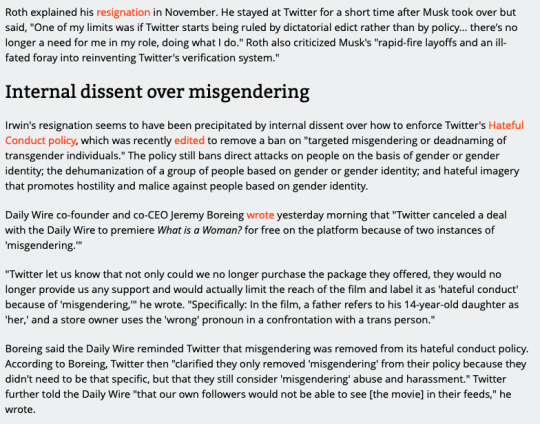


That was it. That was the whole article.
No mention of Matt Walsh proudly talking on Twitter about how he helped spread the "all queers are groomers" rhetoric that's spreading strong throughout much of the US (and it's only a matter of time before that breaches containment). No mention of how Chloe Cole holds rallies to try to make try to make puberty blockers and hormone treatment (which collectively have a regret rate that hovers around 1%) illegal for anyone to access until they're 18 and puberty has already permanently changed their body.
Ars' failure doesn't stop here, though I wish it did. Let's check the comment count:

Now for people who don't read Ars, that number might not mean much. Here it is in context:
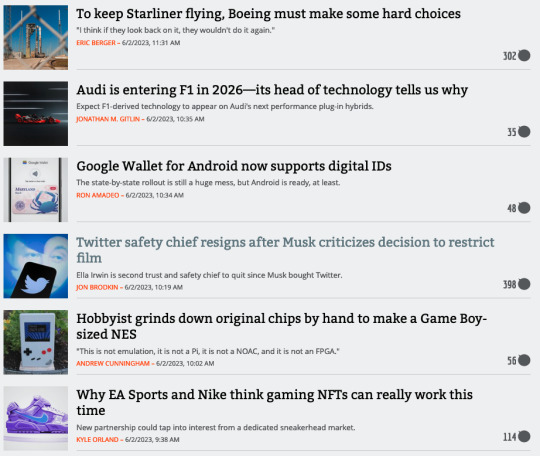
Eight times as many comments as half the stories around it. Three times as many comments as an article about EA and gaming NFTs, topics that are guaranteed to create discussion. The only story that even comes close is a multi-page article about Starliner, a topic which consistently creates strong engagement on a site that cares enough about space to have its own purely-rocket themed sub-periodical.
Remember above when I said that Ars got a reputation as a semi-progressive site because they supported vaccines and the reality of climate change? That extended to the comments section, where their moderators would remove comments that called climate change fake or vaccines a scam. Let's see what kind of comments they're leaving up on this article:
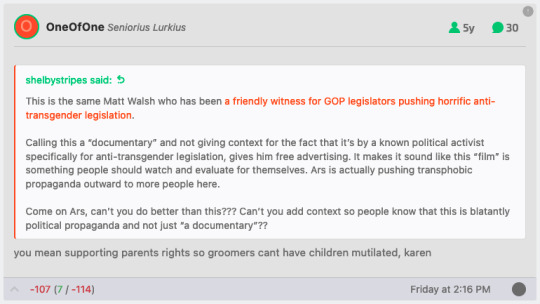
Interesting how some topics are tightly moderated, and others, when they concern human rights, are left to the Ars community (which thankfully downvoted these posts into oblivion).
Save your downvote fingers, though, because these comments are locked to hell and back. No upvotes, no downvotes, no further comments. Just this:
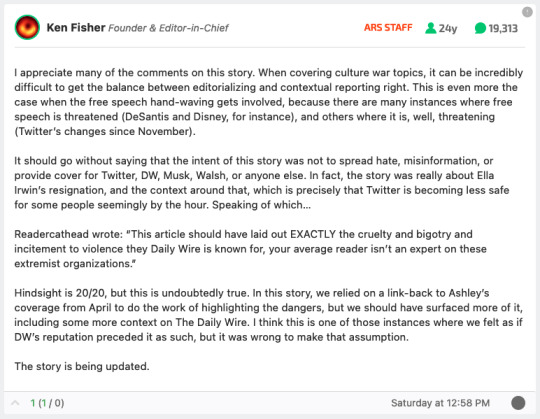
"Culture war topics." "It should go without saying that the intent was not to spread hate." "This story was really about Ella Irwin's resignation... [and] Twitter is becoming less safe for some people seemingly by the hour."
I wonder if Ken Fisher, the founder and editor-in-chief, has any experience with running a site that's becoming less safe for "some people" by the hour? Given how they handled this this weekend, the first weekend of Pride month, I'd say he does.
Catch that part where he said the story is being updated? Here's a Wayback link to the updated version: linkle. Unfortunately it's now long enough to be a multi-page article, which means that putting it into the Wayback machine is a hassle, and it's so much longer that I'm not going to link it in here, but I suggest giving it a read.
Notice anything missing? Anything like... any kind of notice that the article was updated? A timestamp for updates? Nope, gonna just drop a modified version and pretend that this was the only version that ever existed. Thanks for the great article and amazing updates, Jon Brodkin.
...
...
Wait a second. So Jon Brodkin wrote an article that uncritically parroted talking points from an anti-trans propaganda piece made by an openly transphobic Christian nationalist. Is this an honest mistake, or is Jon in on the bit? Let's check who he follows on Twitter (sourced from https://twitter.com/jbrodkin/following).







...and of course:

He follows some green people too, but it's just politicians and fiction writers. No pro-trans publications or pro-trans nonfiction writers. At this point, the lazy response from the journalism team at Ars Technica is pretty clear. Rather than this being a case of uninformed allies making a mistake and trying to cover it up rather than own it, it seems a lot more likely that they have an actual transphobic employee, who intentionally published an actual transphobic article, and the leadership team cares more about protecting his professional reputation than they do about not spreading hate.
Happy fucking Pride.
#ars technica#transphobia#matt walsh#jon brodkin#pride#happy fucking pride i guess#bad journalism#trans rights are human rights
67 notes
·
View notes
Text
Can you imagine what a digital white ethnostate or a cyber caliphate might look like? Having spent most of my career on the inside of online extremist movements, I certainly can. The year 2024 might be the one in which neo-Nazis, jihadists, and conspiracy theorists turn their utopian visions of creating their own self-governed states into reality—not offline, but in the form of Decentralized Autonomous Organizations (DAOs).
DAOs are digital entities that are collaboratively governed without central leadership and operate based on blockchain. They allow internet users to establish their own organizational structures, which no longer require the involvement of a third party in financial transactions and rulemaking. The World Economic Forum described DAOs as “an experiment to reimagine how we connect, collaborate and create”. However, as with all new technologies, there is also a darker side to them: They are likely to give rise to new threats emerging from decentralized extremist mobilization.
Today, there are already over 10,000 DAOs, which collectively manage billions of dollars and count millions of participants. So far, DAOs have attracted a wild mix of libertarians, activists, pranksters, and hobbyists. Most DAOs I have come across in my research sound innocent and fun. Personally, my favorites include theCaféDAO, which aims “to replace Starbucks” (good luck with that!); the Doge DAO, which wants to “make the Doge meme the most recognizable piece of art in the world”; and the HairDAO, “a decentralized asset manager solving hair loss.” But some DAOs use a more radical tone. For example, the Redacted Club DAO, which is rife with alt-right codes and conspiracy myth references, claims to be a secret network with the aim of “slaying” the “evil Meta Lizard King.”
The year 2024 might be one in which extremists start using DAOs strategically. Policies, legal contracts, and financial transactions that were traditionally the domain of governments, courts, and banks can be replaced with smart contracts, non-fungible tokens (NFTs), and cryptocurrencies. The use of anonymous bitcoin wallets and non-transparent cryptocurrencies such as Monero is already widespread among extremists whose bank accounts have been frozen. A shift to entirely decentralized forms of self-governance is only one step away.
Beyond practical reasons that encourage extremists to create their own self-governed structures, there is an ideological incentive too: their fundamental distrust in the establishment. If you believe that the deep state or the “global Jewish elites” control everything from governments and Big Tech to the global banking system, DAOs offer an appealing alternative. Conversations on far-right fringe platforms such as BitChute and Odysee reveal that there is much appetite for decentralized alternative forms of collaboration, communication, and crowdfunding.
So what happens if anti-minority groups establish their own digital worlds in which they impose their own governing mechanisms? What are the stakes if trolling armies start cooperating via DAOs to launch election interference campaigns? The activities of extremist DAOs could challenge the rule of law, pose a threat to minority groups, and disrupt institutions that are currently considered fundamental pillars of democratic systems. Another risk is that DAOs can serve as safe havens for extremist movements by enabling users to circumvent government regulation and security services monitoring activities. They might also allow extremists to find new ways to fundraise, plan, and plot radicalization campaigns or even attacks. While many governments have focused on developing legal frameworks to regulate AI, few have even recognized the existence of DAOs. Their looming exploitation for extremist and criminal purposes is something that has flown under the radar of global policymakers.
Technology expert Carl Miller, who has long warned of potential misuse of DAOs, told me that “even though DAOs behave like companies, they are not registered as legal entities.” There are only a few exceptions: The US states of Wyoming, Vermont, and Tennessee have passed laws to legally recognize DAOs. With no regulations in place to hold DAOs accountable for extremist or criminal activities, the big question for 2024 will be: How can we ensure the metaverse doesn’t give rise to digital white ethnostates or cyber caliphates?
10 notes
·
View notes
Text
What Exactly is Cryptocurrency? A Comprehensive Guide to Get You Started!

The term cryptocurrency has been gaining increasing attention over the past few years, capturing the interest of both investors and the general public. But what exactly is this emerging digital asset? How does it work, and what does it mean for someone new to the world of crypto? In this guide, we’ll walk you through the basics, from the core concepts to real-world applications, offering a complete insight into the rapidly evolving world of cryptocurrency.
What is Cryptocurrency?

Cryptocurrency is a digital asset built on blockchain technology. Unlike traditional currencies, it is not issued by central banks but is created and managed through decentralized technology. The key characteristics of blockchain are its openness, transparency, and immutability, which allow for secure transactions without the need for intermediaries like banks or other financial institutions.
Bitcoin (BTC), created in 2009, is the first and most well-known cryptocurrency. Its creator, Satoshi Nakamoto, aimed to leverage blockchain technology to build a new financial system that operates independently of traditional banking institutions. Since then, countless other cryptocurrencies have emerged, including Ethereum (ETH), Ripple (XRP), and many more.
Different cryptocurrencies have different design goals. Some are used for payments, others for executing smart contracts, while others are primarily investment or store-of-value tools. In essence, cryptocurrencies emerged to address issues in the traditional financial system, such as high transaction fees, long settlement times, and lack of transparency.
Cryptocurrency and Blockchain: The Relationship
To understand cryptocurrency, it’s essential to grasp the underlying technology — blockchain. Simply put, blockchain is a distributed ledger where all participants can view transaction records, but no one can arbitrarily alter them. Each time a transaction is completed, it’s added to a "block," and these blocks are linked in chronological order to form a chain — hence the name "blockchain." This setup ensures that every step of the transaction is traceable and nearly impossible to manipulate.
Another critical feature of blockchain is decentralization, meaning that no single entity controls the system, which, in theory, enhances its security and transparency. The reason cryptocurrencies are so popular is largely due to the independence that blockchain technology provides from traditional financial systems.
Beyond Payments: Cryptocurrency’s Other Use Cases
Although cryptocurrencies were initially designed as digital payment systems, their applications have grown exponentially over time. Here are a few common use cases:
Payment Systems: Cryptocurrencies like Bitcoin are widely used as global payment tools, especially in regions where traditional payment systems are inaccessible, such as countries with unstable political or economic conditions.
Smart Contracts and Decentralized Applications (DApps): Ethereum, beyond being a cryptocurrency, is also a platform for developing smart contracts — self-executing contracts that automatically enforce terms without human intervention. These contracts have broad applications across industries like law, finance, and logistics.
Decentralized Finance (DeFi): DeFi is one of the hottest trends in the crypto world. It aims to create a decentralized financial system where users can lend, borrow, trade, and earn interest on crypto assets without intermediaries like banks. DeFi is seen as more transparent and efficient compared to traditional banking systems.
NFTs and Digital Art: NFTs (Non-Fungible Tokens) are unique digital assets stored on the blockchain. Each NFT has a unique identifier, making it impossible to copy or divide, which has led to their popularity in digital art and collectibles markets.
How to Buy Cryptocurrency?
For beginners, the most common way to buy cryptocurrency is through a crypto exchange. These platforms provide a convenient interface for users to convert fiat money (like USD, EUR, or TWD) into cryptocurrency. Popular exchanges include Binance, Bitget,OKX,Gate·io, Kraken and Bybit. These platforms typically support various payment methods, including bank transfers, credit cards, and third-party payment systems.
Here’s a basic guide to purchasing cryptocurrency:
Create an Account: Choose an exchange and create an account. Most exchanges require identity verification to comply with KYC (Know Your Customer) regulations.
Deposit Funds: Once registered, you can deposit funds via bank transfer or another payment method.
Choose a Cryptocurrency and Place an Order: After depositing, you can select the cryptocurrency you want to purchase, set the quantity, and place an order. Most exchanges offer market orders (buying at the current price) or limit orders (setting a target price).
Transfer to a Wallet: Once your purchase is complete, it’s recommended to transfer your cryptocurrency to a private wallet for safekeeping. Wallets can be online, hardware, or paper-based.
Security Concerns Around Cryptocurrency
While blockchain technology itself is highly secure, cryptocurrency transactions still come with significant risks. Some of the most common include:
Market Volatility: The price of cryptocurrencies can fluctuate wildly in short periods, offering high returns but also posing substantial risks, especially for newcomers.
Scams and Hacking: Fraudulent schemes, like "rug pulls" (where project creators disappear with investors’ money), are common. Exchanges are also frequent targets for hackers, making it crucial to choose a reputable platform and store assets in a secure personal wallet.
Regulatory Risk: Cryptocurrency regulations vary widely across different countries. Some nations ban crypto trading, like China, while others, like the U.S., Singapore, and Hong Kong, are more open. Investors need to be aware of local regulations, especially regarding tax reporting and asset management.
The Future of Cryptocurrency: Opportunities and Challenges
While cryptocurrency has seen significant growth, it still faces several challenges, including market volatility, regulatory uncertainty, and the need for improved user experiences. Stablecoins, like USDT and USDC, have emerged to address price volatility, offering a more stable investment option. However, as governments increasingly seek to regulate the sector, the industry’s transparency and legitimacy are likely to improve over time.
On the technological front, high-energy consumption is a critical issue for some cryptocurrencies, especially Bitcoin. However, projects like Ethereum's switch to a Proof-of-Stake (PoS) model, which is more energy-efficient than traditional Proof-of-Work (PoW), signal an environmentally friendly future for blockchain. With continuous advancements in technology and growing mainstream adoption, cryptocurrency is poised to become a significant part of our daily lives.
Conclusion
Cryptocurrency represents a transformative financial tool, offering new possibilities through decentralization, transparency, and efficiency. From Bitcoin to Ethereum, and from DeFi to NFTs, the scope of cryptocurrency’s application continues to expand, offering unprecedented opportunities for investors, developers, and everyday users.
Despite its potential, investing in cryptocurrency carries risks, particularly in terms of volatility, security, and regulatory uncertainty. However, for those willing to invest time in understanding the landscape and remaining patient as the technology matures, cryptocurrency presents an exciting frontier to explore.
Whether you’re a beginner or a seasoned crypto enthusiast, understanding the fundamental concepts and future prospects of this rapidly evolving field is key to thriving in the industry. As technology continues to develop and mainstream applications grow, cryptocurrency could become an integral part of our financial system, reshaping our understanding of money, transactions, and assets.
2 notes
·
View notes
Text
Common Questions About Solana Token Minting Answered
As the cryptocurrency world continues to expand, more and more developers, entrepreneurs, and enthusiasts are looking into token minting as a way to create their own digital assets. Among the various blockchain platforms available, Solana has emerged as a leading choice for token minting due to its high-speed transactions, low costs, and robust scalability. However, with the rise in interest comes a slew of questions from those new to the process. In this article, we’ll answer some of the most common questions about Solana token minting, providing clear and positive insights into why this platform is ideal for your token creation needs.

What Is Token Minting?
Token minting refers to the process of creating new tokens on a blockchain. These tokens can represent anything from digital currencies and assets to loyalty points, collectibles, and more. Minting tokens allows you to define the total supply, distribution, and unique characteristics of your tokens, which can then be used in a variety of applications such as decentralized finance (DeFi), non-fungible tokens (NFTs), gaming, and more.
Why Choose Solana for Token Minting?
Solana has quickly gained a reputation as one of the fastest and most cost-effective blockchain platforms for token minting. Here’s why Solana stands out:
High Transaction Speed: Solana is capable of processing up to 65,000 transactions per second (TPS), making it one of the fastest blockchains available. This speed ensures that your tokens can be created, transferred, and traded quickly and efficiently.
Low Transaction Fees: Unlike some other blockchains where transaction fees can be prohibitively high, Solana’s fees are a fraction of a cent. This affordability is particularly beneficial for those looking to mint large quantities of tokens or those planning to use their tokens in high-frequency trading environments.
Scalability: Solana’s innovative Proof of History (PoH) consensus mechanism ensures that the network remains scalable even as demand grows. This scalability makes Solana an excellent choice for projects that expect to handle a large number of users or transactions.
Developer-Friendly Tools: Solana offers a range of tools and resources, such as the Solana token generator and Instant Token Launcher, that make it easy for developers to create and deploy their tokens.
How Do I Mint a Token on Solana?
Minting a token on Solana is a straightforward process, thanks to the developer-friendly tools provided by the platform. Here’s a step-by-step guide to get you started:
Set Up a Solana Wallet: Before you can mint a token, you’ll need to set up a Solana wallet. This wallet will hold your SOL tokens, which are used to pay for transaction fees on the network.
Use the Solana Token Generator: The Solana token generator is a powerful tool that simplifies the process of creating tokens on the Solana blockchain. Simply input your desired token details, such as the name, symbol, and total supply, and the generator will create your token in seconds.
Launch Your Token: After creating your token, you can use the Instant Token Launcher to deploy it on the Solana blockchain. This tool allows you to instantly launch your token, making it available for trading, distribution, or integration into your application.
Distribute Your Tokens: Once your token is launched, you can distribute it to your intended recipients, whether they are investors, users, or community members. You can also list your token on cryptocurrency exchanges to increase its liquidity and visibility.
What Are the Costs Involved in Minting Tokens on Solana?
One of the most attractive aspects of minting tokens on Solana is the low cost. The transaction fees on the Solana network are minimal — often just a fraction of a cent per transaction. This means that even if you’re minting a large number of tokens, the total cost will remain affordable.
Additionally, the Solana token generator and Instant Token Launcher tools are designed to be cost-effective, allowing you to create and deploy your tokens without the need for expensive development resources. This makes Solana an ideal choice for startups, small businesses, and individual developers looking to enter the cryptocurrency market without breaking the bank.
Can I Mint Any Type of Token on Solana?
Yes, Solana supports the minting of a wide variety of tokens. Whether you’re looking to create a utility token, security token, non-fungible token (NFT), or even a memecoin, Solana’s flexible and scalable infrastructure can accommodate your needs.
Utility Tokens: These tokens can be used within a specific ecosystem or application, providing users with access to products, services, or other benefits.
Security Tokens: Representing ownership of an asset, such as equity in a company or real estate, security tokens are subject to regulatory requirements.
Non-Fungible Tokens (NFTs): NFTs are unique tokens that represent ownership of a specific digital asset, such as artwork, music, or virtual real estate.
Memecoins: Inspired by internet memes and viral trends, memecoins are a fun and playful way to engage with the crypto community.
With Solana’s tools like the Instant Token Generator, you can create these types of tokens quickly and efficiently, enabling you to capitalize on market trends and innovations.
What Are the Benefits of Minting Tokens on Solana Compared to Other Blockchains?
When compared to other popular blockchains like Ethereum or Binance Smart Chain, Solana offers several distinct advantages:
Speed: Solana’s high transaction speed outpaces that of Ethereum and Binance Smart Chain, ensuring that your tokens can be minted and traded quickly. This speed is particularly important for applications that require real-time transactions, such as gaming or DeFi platforms.
Low Costs: The transaction fees on Solana are significantly lower than those on Ethereum, where gas fees can be a major obstacle for developers and users alike. Solana’s low fees make it a more accessible platform for those looking to mint large quantities of tokens or engage in frequent transactions.
Scalability: Solana’s Proof of History (PoH) consensus mechanism enables the network to scale without compromising on security or decentralization. This scalability ensures that your project can grow and handle increased demand without facing performance bottlenecks.
Ecosystem Support: Solana’s growing ecosystem includes a wide range of tools, services, and resources that make it easier for developers to build and deploy their projects. The Solana token generator and Instant Token Launcher are just two examples of the developer-friendly tools available on the platform.
How Do I Promote My Solana-Minted Tokens?
Once you’ve minted your tokens on Solana, the next step is to promote them to your target audience. Here are a few strategies to help you get started:
Build a Community: Community is key to the success of any token. Use social media platforms, forums, and online communities to build a strong following for your token. Engage with your audience regularly and provide them with updates, news, and incentives to participate.
Leverage Social Media: Social media platforms like Twitter, Reddit, and Discord are essential tools for promoting your token. Share news, updates, and memes to generate buzz and attract new followers.
List Your Token on Exchanges: Listing your token on cryptocurrency exchanges can increase its visibility and trading volume. Many exchanges support Solana-based tokens, making it easier to get your token listed and accessible to a broader audience.
Collaborate with Influencers: Partnering with influencers in the crypto space can help you reach a larger audience and build credibility for your token. Look for influencers who align with your brand and values.
What Are the Risks of Token Minting?
While minting tokens on Solana offers numerous benefits, it’s important to be aware of the potential risks involved:
Market Volatility: Cryptocurrency markets are notoriously volatile, and the value of your tokens can fluctuate dramatically based on market conditions, news, and investor sentiment.
Regulatory Compliance: Depending on the type of token you mint, you may need to comply with specific regulatory requirements. Be sure to research the legal implications of your token and consult with legal professionals if necessary.
Security: As with any digital asset, security is a critical concern. Ensure that your token smart contracts are thoroughly tested and audited to prevent vulnerabilities and potential hacks.
Conclusion: Why Solana Is the Best Choice for Token Minting
In conclusion, Solana offers a powerful and flexible platform for token minting, making it an excellent choice for developers, entrepreneurs, and crypto enthusiasts alike. With its high transaction speed, low fees, and scalability, Solana provides the ideal environment for creating a wide variety of tokens, from utility tokens and NFTs to memecoins and more.
Tools like the Solana token generator and Instant Token Launcher further simplify the process, allowing you to mint and launch your tokens quickly and efficiently. Whether you’re looking to create a new digital currency, launch a DeFi project, or simply experiment with token minting, Solana offers the resources and support you need to succeed.
As you embark on your token minting journey, remember to stay informed about market trends, engage with your community, and prioritize security. With the right approach, your Solana-minted tokens have the potential to thrive in the dynamic and ever-changing world of cryptocurrency.
2 notes
·
View notes
Text
Surfer: Year Ten
And the day has come. Ten years of my humble blog and of a slogan that has taken on a life of its own. A decade is a long time, and the occasion puts me in an introspective frame of mind. Even in a relatively quiet existence such as mine, a person can amass a sizable collection of milestones over that time. Not to mention the gray hairs. I taught myself a new language, learned how to draw somewhat competently, took up 3D modelling with a modest degree of success, I helped a friend create a commercial computer game, at one point I took up writing and had a blog which was fairly popular in its political niche. Some of the things I made had appeal broad enough that a prosecutor and some local three letter agency really wanted to get to know me. That counts as an achievement, right? I got much better at my job, but I'm trying to change trades. I was also fortunate enough to have spent most of the last 10 years with one woman, this was a "big one" on the list.
As for Surfing the Kali Yuga - I'm still amazed this slogan of mine (although I can only take partial credit for coming up with it) caught on as well as it did. Obviously it very much helped that Zentropa took a liking to it and produced a few pictures. My blog on its own wouldn't be enough to popularise, well, anything. In this little corner of the Internet I make more of a "mood board" than anything else. The funny thing is "I" even have my own entry on Know Your Meme. It is, as one could expect, rubbish and cites a random 4chan anon as the source, in a post that is well over a year younger than my original (damn the Tumblr purge of 2019) blog. But it is fun to see some form of "Surfing the Kali Yuga" on every social platform, t-shirt store or anywhere really. Some accounts are quite similar to my blog, some not so much. I even saw anarchists and hippies (I apply the term very loosely) using STKY in one context or another. The most unusual thing was the Bored Ape Yacht Club connection. Internet sleuths, and by sleuths I mean Twitter dimwits, decided that NFTs are a "Nazi subterfuge" and tried connecting the biggest company with "alt-right dog whistles". After bending over backwards and reaching so far up their own asses they could feel the stomach acid burning they connected those Damn Dirty Apes to our favourite catchphrase. Cue one hour long ramblings on YouTube about alt-right ape conspiracy which would make Alex Jones blush. On a more positive note my blog is a cited source, I wrote about it here. Sometimes I encounter people who know my blog when I really wouldn’t expect them to, it never fails to brighten my mood.
One of these days I'll do a proper deep dive into the diffusion of STKY, in the meantime I actually made something for the decennary. I don't often draw for fun, but this time I had to. I also have a bottle of kvass in the fridge waiting for me. Here's hoping I'll still be here in another year. Or ten.
22 notes
·
View notes